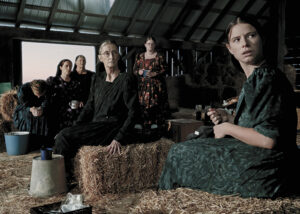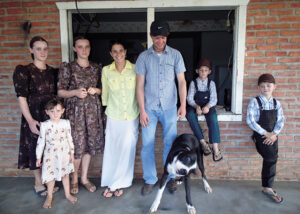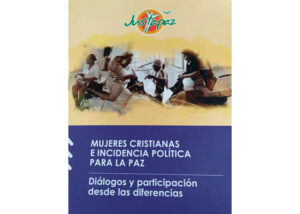We are accustomed to reading the narrative of the Annunciation (Luke 1:26-38) as something of an ethereal event, a moment of encounter with the divine realm during which Mary’s feet didn’t quite touch the ground. But in our preoccupation with the other-worldly, we can overlook the fact that this is one of the most this-worldly narratives in the entire Bible, since its principal concern is Mary’s sharing of her body and blood with God, making it possible for God to become incarnate. [1]
So, what must it have been like to be the person in whom God became flesh, to make space within one’s body for God’s body, to knit God together in one’s womb? In one sense, it must have been much like any other pregnancy—which, I can say from experience, is not for the faint of heart! When I was pregnant with my son, the physical changes my body underwent were more drastic than I was expecting; it takes a lot for a body to adjust to accommodate—to house—another body within the same skin. By the end, this task becomes something of a (literal) burden!
But alongside the physical changes, I found that my pregnant body taught me slowly to turn my attention toward another, toward that tiny image of God within me. Thus, pregnancy is far from a time of passive waiting. Instead, ordinary acts of caring for oneself—eating, a daily walk, sleeping enough, not overworking—becoming ethical acts, generous acts of loving another as oneself. In this sense, in pregnancy, I existed in a liminal space between being a mother and not being one yet, of being one person and yet two. And the paradox of parenthood began to dawn on me too, since the child within my body was both my flesh and blood, bound to me in the most intimate of relationships, but was also other, and, as yet unknown, since I had not yet even seen his face. Thus, there is a sense in which a pregnant woman doesn’t merely practice hospitality, but embodies it.
Did Mary know that she was taking on all this when she said “yes” to Gabriel that day? Living in a context where pregnancy was far more common than it is in ours, she probably knew quite a bit about it. But, of course, hers was in another sense no ordinary pregnancy. Hers was the ultimate instance of welcoming and making space for another – no, for the very otherness of God. Theologian Rose Ellen Dunn describes the moment of the Annunciation this way: “Mary, filled with grace, is beckoned by the divine into possibility; responding in grace, she in turn beckons the divine into possibility. Transgressing the limits of language, this possibility slips into . . . a moment of Gelassenheit: a mutual ‘letting be’ or releasement of Mary and the divine into a mystical union of love.” [2]
So what fostered in Mary this kind of radical openness? Well, her revolutionary hymn, the Magnificat, attests that Mary was steeped in her own Jewish tradition and Scriptures, and she most certainly would have been familiar with the key biblical notion of welcoming the stranger.
Appearing four times in the first five books of the Bible (the Pentateuch, Torah, or Law), the command to love or welcome the stranger was clearly central in Israelite understanding, and was linked with the care for widows and orphans. Leviticus 19 speaks about loving the stranger as yourself, “for you were [strangers] in the land of Egypt” (Lev. 19:33-34; see also Exod. 22:21, Deut. 10:19, 24:17-21, NRSV). In other words, God calls Israel to extend a particular welcome to the outsider, the one not at home, the one who is vulnerable and thus in need of hospitality.
Isn’t it likely that Mary drew on this tradition when faced with the ultimate stranger, the one who was radically other and yet became completely vulnerable – the God-child, Jesus? In God’s act of becoming a human child within her, Mary read God’s love for the most vulnerable: for herself as a young peasant woman, for her nation, straining under Roman occupation, for all the humble, meek, and hungry over the proud and the rich; and she responded with a reciprocal love and welcome. She said, “Let it be with me according to your word” (Luke 1:38).
But all this suggests that Mary wasn’t simply agreeing to be a mother—or rather, she wasn’t agreeing to some privileged, idealized, sanitized version of motherhood. She was agreeing to be a key co-operator with God in the coming of the Messiah, and with him, the Reign of God. This was not only a daunting task, but a dangerous one. Indeed, as a poor woman in first-century Palestine, pregnancy and birth alone placed Mary’s life at risk. Theologian Tina Beattie speaks of Mary as having “been on a spiritual and physical journey with her sisters into the lonely birthing places of the poor, into the wilderness of the refugee. She had visited the world of women’s struggle and pain, and she would do so again.” [3]
But though Mary may have flinched when she glimpsed, in the angel Gabriel and his words, the enormity of the task ahead, she undertook it anyway. And that is what is all the more remarkable about Mary’s profound hospitality: she offered what she herself, and her son after her, were continually denied. Think of the rest of her story. Near the end (during the “burden” stage) of her pregnancy, she was forced to travel to Bethlehem to be taxed, an excruciatingly uncomfortable journey which may have caused her to go into early labour. And there, in Bethlehem, there was no room for her and Joseph, and she had to labour and give birth in a filthy stable. Beattie speaks of Jesus’ birth as Mary’s “own physical passion,” stating, “Rejected by society and lying in a barn among animals, she suffered for the salvation of the world.” [4] Afterwards, Mary and Joseph fled to Egypt as refugees, unable to find any safety or home in their own land. And of course, in the ultimate rejection of Jesus’ death on the cross, when evil and sin tried to render Christ utterly unwelcome, Mary was subjected to one of the worst forms of grief: the violent death of her son. Despite and in the face of all of this rejection and unwelcome which was to come, the Incarnation began with Mary saying yes to God’s request for hospitality.
What, then, is our calling, as followers of Mary’s son? Perhaps drawing on something his mother taught him, Jesus reaffirms and reinterprets the idea of welcoming the stranger in Matthew 25, in the parable of the sheep and the goats. Jesus tells the sheep that they are blessed and can enter into the kingdom, since, among other acts of mercy, he lists, “I was a stranger and you welcomed me” (Matt. 25:34-36). And when they wonder when it was that they offered him hospitality, he says, “Truly I tell you, just as you did it to one of the least of these who are members of my family, you did it to me” (v. 40). In Jesus’ interpretation, the “least” are to be viewed as the face of Christ himself, as God-with-us.
In our time of consumerist excess and retreat into close-knit, exclusive family circles, this idea of making space for a stranger seems vastly removed from our reality, and such an invasion of our individualistic notions of privacy. We would so much rather settle for the domesticated version of the Christmas narrative, for that ethereal Mary who hovers somewhere just above the ground. Instead, during this time of Advent, we’re called to watch and wait the way the flesh-and-blood Mary did. Her son calls us to what she exemplifies in the Annunciation: a faith-filled openness to the unknown, a courageous commitment to risk welcoming the stranger, an eschatological hope that we can participate in God’s inbreaking, upside-down reign of justice and peace. And in this sense, as thirteenth-century mystic Meister Eckhart once said, “We are all meant to be mothers of God.” [5]
[1] A version of this reflection was given during a chapel service at Canadian Mennonite University a few weeks ago.
[2] Rose Ellen Dunn, Finding Grace with God: A Phenomenological Reading of the Annunciation (Eugene, OR: Pickwick, 2014), 2.
[3] Tina Beattie, Rediscovering Mary: Insights from the Gospels (Liguori, MO: Triumph Books, 1995), 85.
[4] Beattie, Rediscovering Mary, 57.
[5] Matthew Fox, ed. and trans., Meditations with Meister Eckhart (Santa Fe, NM: Bear & Co., 1983), 74.






